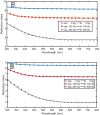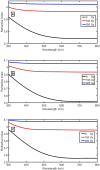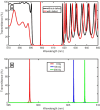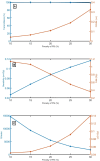Theoretical study of doped porous silicon in cantor quasi periodic structure for gamma radiation detection
- PMID: 40301423
- PMCID: PMC12041297
- DOI: 10.1038/s41598-025-94555-4
Theoretical study of doped porous silicon in cantor quasi periodic structure for gamma radiation detection
Abstract
This study looks at two photonic crystals that are similar to Cantor's and are separated by a thin layer of sensitive, porous silicon made of poly(ethylene oxide) nanocomposite and potassium iodide, which is used as a gamma indicator. Modifications in the distinct peak versus the irradiation dose track how the proposed indicator responds to radiation. The results demonstrate that gamma radiation alters the refractive index of the poly(ethylene oxide) nanocomposite, causing the distinct peaks to shift. The impact of doping of nanocomposite with potassium iodide, the porosity of silicon, and the cell's number is analyzed. Doping the sensitive nanocomposite with potassium iodide showed a negative effect. The proposed indicator recorded a high sensitivity of 0.218 nm/Gy (nm/Gy = nanometer/gray) for low gamma doses up to 100 Gy, and a moderated sensitivity of 0.13 nm/Gy for high gamma dose from 100 to 200 Gy. The suggested indicator demonstrated high sensitivity in low gamma detection.
Keywords: Cantor structure; Gamma radiation; Polymer films; Potassium iodide; Quasi-periodic.
© 2025. The Author(s).
Conflict of interest statement
Declarations. Competing interests: The authors declare no competing interests. Ethics declarations: This article does not contain any studies involving animals or human participants performed by any authors.
Figures












Similar articles
-
Quasi periodic photonic crystal as gamma detector using Poly nanocomposite and porous silicon.Sci Rep. 2025 May 27;15(1):18451. doi: 10.1038/s41598-025-02910-2. Sci Rep. 2025. PMID: 40419577 Free PMC article.
-
Topological edge state resonance as gamma dosimeter using poly nanocomposite in symmetrical periodic structure.Sci Rep. 2025 May 22;15(1):17753. doi: 10.1038/s41598-025-02352-w. Sci Rep. 2025. PMID: 40404731 Free PMC article.
-
Photonic crystal with a defect layer of silicon containing polymer nanocomposites as radiation detector.Sci Rep. 2025 Mar 7;15(1):7935. doi: 10.1038/s41598-025-91050-8. Sci Rep. 2025. PMID: 40050332 Free PMC article.
-
A doped-polymer based porous silicon photonic crystal sensor for the detection of gamma-ray radiation.RSC Adv. 2023 Jan 19;13(5):3123-3138. doi: 10.1039/d2ra07637c. eCollection 2023 Jan 18. RSC Adv. 2023. PMID: 36756394 Free PMC article.
-
Tissue responses to low protracted doses of high LET radiations or photons: early and late damage relevant to radio-protective countermeasures.Adv Space Res. 1989;9(10):299-313. doi: 10.1016/0273-1177(89)90453-5. Adv Space Res. 1989. PMID: 11537307 Review.
Cited by
-
Terahertz metasensor with pseudo parity time symmetry for oral cancer diagnostics.Sci Rep. 2025 Aug 11;15(1):29424. doi: 10.1038/s41598-025-14176-9. Sci Rep. 2025. PMID: 40790059 Free PMC article.
References
-
- Starkey, T. & Vukusic, P. Light manipulation principles in biological photonic systems. Nanophotonics2, 289–307. 10.1515/nanoph-2013-0015 (2013).
-
- Ameen, A. A., Al-Dossari, M., Zaky, Z. A. & Aly, A. H. Studying the effect of quantum dots and parity-time symmetry on the magnification of topological edge state peak as a pressure sensor. Synth. Met.292, 117233. 10.1016/j.synthmet.2022.117233 (2023).
-
- Yeh, P. Optical Waves in Layered Media (Wiley, 1988).
-
- John, S. Strong localization of photons in certain disordered dielectric superlattices. Phys. Rev. Lett.58, 2486. 10.1103/PhysRevLett.58.2486 (1987). - PubMed
-
- Al-Dossari, M., Zaky, Z. A., Awasthi, S. K., Amer, H. A. & Aly, A. H. Detection of glucose concentrations in urine based on coupling of Tamm–Fano resonance in photonic crystals. Opt. Quant. Electron.55, 484. 10.1007/s11082-023-04621-2 (2023).
LinkOut - more resources
Full Text Sources

